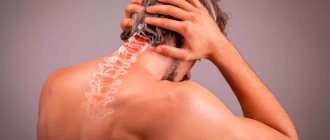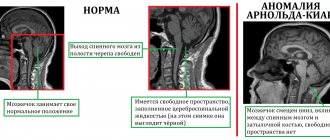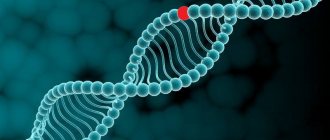Find out more about other diseases starting with the letter “C”: Compression of the brain; Senile chorea; Sensitive ataxia; Serous meningitis; "Rigid person" syndrome; Alien hand syndrome; Restless legs syndrome; Bogorad syndrome; West syndrome; Gaye-Wernicke syndrome; Guillain-Barre syndrome; Piriformis syndrome; Carpal tunnel syndrome; Carotid sinus syndrome; Kleine-Levin syndrome; Klippel-Feil syndrome; Cauda equina syndrome; Crumpy syndrome; Lambert-Eaton syndrome; Landau-Kleffner syndrome.
Crampy syndrome is paroxysmal painful contractions of individual muscles or muscle groups, characterized by a short duration and involuntary occurrence. They occur at night and are essentially cramps of the calf muscles. The duration of the attack varies from several seconds to minutes.
The diagnosis can be established after electromyography, laboratory and instrumental examinations, taking into account clinical manifestations. Treatment is aimed at eliminating the pathogenetic mechanisms and symptoms of the disease.
Crumpy: what is it and why does it occur?
Involuntary muscle contractions most often appear unexpectedly or after physical activity. They capture the entire muscle or part of it. The spasm manifests itself as a muscle roll, hard to the touch.
During the daytime, the syndrome worries people suffering from local neuroosteofibrosis in the area of the popliteal fossa with vegetative-irritative manifestations in cervical and lumbar osteochondrosis. At night, seizures occur in patients with clear cerebral disorders. Crampy syndrome appears day and night, usually in persons with cerebral, local and spinal disorders.
How do crampies appear?
Most often, cramps occur in the distal parts of the lower extremities. But in some neurological diseases they can be observed in the intercostal, cervical and facial muscles, in the thigh and arm.
Muscle spasms during cramps are local, usually one-sided, and develop suddenly and without warning. Although, if increased physical activity is a provoking factor, a feeling of muscle fatigue may be noted. Such convulsions are not characterized by confusion or loss of consciousness.
Crumpy is tonic in nature, that is, it is not accompanied by twitching of the muscle itself or its individual fibers. But in some diseases, concomitant fasciculations may appear at the beginning and end of crampial cramps, involving the same area. Less common are background generalized fascicular twitches in different muscle groups. A combination of tonic and local clonic convulsions occurs in ALS, some hereditary diseases with muscle pathology, and paraneoplastic syndrome.
With cramps, intense, sudden pain occurs at the site of the spasm. When palpated, a painful, dense ridge is noted here; deformation and excessive contouring of the muscle are often visible.
With cramping, a forced position of the part of the body involved in the process appears. Tonic contraction of the gastrocnemius muscle causes hyperextension of the leg at the ankle joint, which is accompanied by secondary spasm of the arch and toe flexor muscles. If the cramp occurs in the intercostal muscles, inspiratory volume may temporarily decrease. Sudden severe chest pain can mimic acute diseases of the respiratory and cardiovascular systems.
After relief of an acute spasm, local aching pain and a feeling of muscle fatigue may persist for some time.
Causes of painful muscle contractions
Factors that provoke the development of spasms are the following:
- Iatrogenic. In other words, they appear as a result of therapy, after hemodialysis, treatment with diuretics and taking lithium drugs.
- Metabolic. Convulsions can occur due to liver cirrhosis, tetany, hypothyroidism, gastrectomy, and various electrolyte disturbances. Moreover, sudden muscle spasms often bother women carrying a child, especially at 6-7 months.
- Neurological. Such factors play a significant role in the appearance of involuntary muscle contractions. Neurological causes include amyotrophic lateral sclerosis and other pathologies of the anterior horn.
Sudden muscle contractions also occur as a result of myotonic type disorders, rigid person syndrome (rare), and hyperactivity of motor units. It can also be triggered by spasms, which are caused by systemic damage to the tissues of the lower extremities. For example, with diffuse myositis and Becker's dystrophy.
In addition to the reasons listed, the following ailments can lead to the appearance of painful muscle contractions: myalgia syndrome, lameness, exposure to toxic substances on the body (strychnine and insecticides). Experts sometimes talk about idiopathic seizures, which are associated with the individual structure of the body, hereditary factors and personal predisposition.
In completely healthy people, crampy syndrome can occur due to dehydration, heavy alcohol intoxication, or excessive physical activity. Pathologies of peripheral muscles, veins, arteries and nerves contribute to the development of painful spasms.
At rest, such attacks occur as an early manifestation of amyotrophic lateral sclerosis. Crumpy syndrome manifests itself in the muscles of the lower jaw, thighs, tongue, neck, back, abdomen and arms. Such painful spasms can still be observed in the presence of such factors:
- Damage to peripheral nerves in the form of sensory disturbances such as burning, tingling, painful sensitivity or numbness.
- Lack of iron and magnesium.
- Becker's muscular dystrophy. This genetic disease is characterized by damage to the proximal muscles of the lower extremities.
- Use of certain medications.
- Pain in the lumbar region, spreading to the legs.
- Hemodialysis and plasmapheresis are procedures aimed at extrarenal blood purification.
- Intervertebral hernia.
Cramps quite often occur during pregnancy, as well as during obliterating atherosclerosis of the legs, during which blood circulation is completely or partially disrupted due to blockage of blood vessels with cholesterol plaques.
Main signs of the disease
Crampy syndrome is not a disease; most likely, it is a phenomenon that manifests itself even in a healthy person. In most cases, it affects the lower extremities, especially the quadriceps femoris.
Symptoms and treatment of Crampy syndrome are aimed at alleviating the patient’s condition. During an involuntary spasm, the muscle becomes hard, very painful and tense. Women carrying a baby regularly experience such unpleasant sensations at night. To alleviate the condition, you should massage the sore spot and engage in passive stretching of pinched tissues.
Attacks most often occur in a horizontal position at night, as well as after physical exertion. Under such conditions, the tissue is capable of intense and rapid contraction. The occurrence of cramps is caused by the fact that the antagonist muscles do not provide resistance. To activate their work, you just need to change your body position. For example, getting out of bed, leaning on a sore limb. Sometimes such attacks occur in the diaphragm or chest. In this case, lung and heart diseases may develop.
Is it dangerous?
Crumpies are not life-threatening. But, of course, experiencing such cramps for a long time is quite unpleasant, like any other painful sensations. The presence of such feelings in any case affects a person’s life.
And it’s unlikely that anyone will refuse to keep cramps to a minimum. If a person becomes seriously concerned about their appearance, if seizures become frequent, daily, it is worth consulting a doctor. In addition, sometimes muscle soreness after cramps persists for several days, and this is a very good reason to go to a medical facility.
It is worth adding here that cramps are almost the only clinical symptom of some neurological diseases in the early stages. But crampies themselves do not lead to them, they are only a consequence.
How to identify Crampy syndrome
ICD-10 (International Classification of Diseases) includes painful spasm, the diagnosis of which is aimed at detecting the underlying pathology. The ICD-10 code is M79.1. An attack can be provoked directly during a medical examination by squeezing the calf. After the initial examination, the patient may be referred for a blood test to determine hormone levels and biochemical profile. They also check the electrolyte content.
By the way, some diagnostic techniques, for example, electromyography without seizures will not provide a specialist with useful information. When an EMG detects a seizure, the neurologist can see important abnormalities and changes.
How to get rid of painful cramps
Crampy syndrome, the treatment of which is aimed at restoring the functioning of muscles that act as antagonists of spasm, is not considered a pathology. This phenomenon is most likely a feature of the tissues of the human body.
When a painful cramp appears, you should pull your foot upward with all your might, while keeping your knee straight. In this way, it will be possible to stretch a muscle that is seized by a sudden spasm. With this technique you can get rid of severe pain. Some people with crampy syndrome are helped by pressing their feet firmly on the floor surface. But the first method is considered more effective.
You can eliminate involuntary muscle contractions using other methods:
- walking on your heels for 2-3 minutes;
- a hot foot bath or shower, the duration of warming the affected muscle should be at least 5 minutes;
- walking with high legs;
- massage using ice cubes.
Treatment of neurological causes
Crampy fasciculations syndrome is a symptom of a large number of neurological diseases, including amyotrophic lateral sclerosis. With such an illness, it is unlikely that it will be possible to stop an attack using the methods listed above. For treatment in this case, powerful medications are used - Diazepam, Baclofen and other similar drugs. Of course, they can only be used as prescribed by a neurologist.
Quite often, complications of lumbar osteochondrosis result in painful muscle contractions. In this case, all medications and methods that are usually used to treat the underlying disease become effective.
Night cramps (cramps)
Night cramps are painful tension in the calf muscles (colloquially called cramps) during sleep. They occur at all periods of life, but with greater frequency in adolescents and adults. Can sometimes lead to fatigue while awake. To reduce their severity use:
- massage;
- active movements in the limbs;
- local heat;
- in some cases, taking medications as prescribed by a doctor is indicated.
Make an appointment with a pediatric neurologist by phone
Services and prices
Primary appointment (examination, consultation) with a neurologist
2,200 rub.
Repeated appointment (examination, consultation) with a neurologist
2,100 rub.
Preventive appointment (examination, consultation) with a neurologist
2,000 rub.
Comprehensive program “Sleep disorders in children under 3 years of age”
6,900 rub.
EEG monitoring for up to 24 hours
4,200 rub.
Bobrovnikova Ekaterina Aleksandrovna Pediatric neurologist Work experience: 31 years
Drug therapy
When crampy syndrome bothers you regularly, it is recommended to use mineral and vitamin complexes to saturate the body with useful substances. But first you should consult your doctor, informing him about all the medications you are currently taking. The most popular medications for painful cramps containing magnesium and calcium are Asparkam and Panangin.
Crampy syndrome causes, symptoms and treatment of which are aimed at eliminating spasm, in some situations requires more serious measures. If a person suffers from a chronic disease, for example, diabetic polyneuropathy, then he needs complex treatment. In this case, alpha-lipoic acid drugs are prescribed to restore the affected nerves.
Diagnostics
The conclusion about the presence of Crampy syndrome is established on the basis of symptoms and the results of diagnostic studies. Differential diagnostic measures are designed to exclude the presence of restless legs syndrome, muscle contractures, titania, dystonia and other diseases. It is important for the doctor to find out the presence of the cause that forms the secondary crampi syndrome. It is important to follow all diagnostic rules:
- Collecting anamnesis, studying patient complaints. During the conversation, the presence of concomitant pathologies is established, complaints are clarified, and information about taking medications appears. Family history helps determine whether blood relatives have symptoms of the disease.
- Physical examination. Areas susceptible to convulsive attacks are examined, the presence of hypertrophic changes, increased tone, and muscle twitching is revealed.
- Laboratory diagnostics. It is mandatory to study general urine and blood tests, determine the amount of glucose in the blood, CPK, liver tests, urea and creatinine levels, analysis of protein composition and water-electrolyte balance. Lack of potassium, magnesium, potassium, surges in parathyroid hormone, T3, T4 indicate the presence of Crampy syndrome.
- Electroneuromyography. If involuntary muscle activity is recorded from 50 to 150 Hz, the seizures are said to be neurogenic. “Mute cramps”, in which there is no muscle activity, indicate a metabolic disorder.
Additional hardware research. CT, MRI of the spine, ultrasound of the vessels of the legs help to establish primary diseases and carry out adequate differential diagnosis.
Prevention of the development of the syndrome
To avoid painful spasms, doctors advise performing special muscle stretching exercises. In addition, exercise on an exercise bike is an effective measure in the fight against the disease. As a preventative measure, experts recommend drinking enough water and wrapping your feet in a blanket while sleeping. You should also give up alcoholic beverages and minimize the consumption of tea and coffee.
Leg cramps treatment for various diseases
We have identified a wide range of different diseases that can cause painful muscle spasms. After reading this article, you will be able to identify a possible pathology and take action.
The most common cramps are not very painful, periodic, not frequent (1-2 times a month). Such conditions are not cause for concern and do not require special treatment.
Which doctor should I contact for leg cramps?
- For more frequent and painful episodes or worsening spasms, find a specialist. To do this, you should first contact a pediatrician , if we are talking about children under 18 years of age, or a therapist . After conducting a screening survey and examination, the local doctor will give the necessary recommendations and referrals for tests and to specialists.
- For diseases of the nervous system, he will refer you to a neurologist .
- If the seizures are unprovoked, then you should contact an epileptologist and conduct an EEG to exclude the diagnosis of epilepsy.
- In case of pathology of the musculoskeletal system, see an orthopedist .
- For liver disorders - an endocrinologist , gastroenterologist or infectious disease specialist.
- In case of kidney pathologies - see a nephrologist , you should first conduct a general urine test, a general blood test, a urine sample according to Zimnitsky and Nechiporenko, a biochemical blood test, an ultrasound of the kidneys and bladder.
- For varicose veins of the lower extremities, get a referral to a phlebologist, vascular surgeon or surgeon, and an ultrasound examination of the vessels of the extremities is also required.
- If a tumor is suspected, a consultation with an oncologist and a general blood test are required.
- In case of pathology of the endocrine system (diabetes mellitus, obesity), see an endocrinologist , blood test for sugar and other biochemical tests.
What to do for leg cramps in different situations
If there is a deficiency of calcium, magnesium, potassium, foods containing the missing microelements should be included in the diet: dried apricots, nuts, raisins, grapes, bran.
What vitamins are needed for leg cramps?
Drug treatment with calcium preparations: Calcemin Advance, Calcium D3-Nycomed, Complivit Calcium D3, Calcium Sandoz Forte; biological supplements from the pharmacy chain: Mountain calcium, Sea calcium.
Magnesium preparations: Magnerot, Magne B6, Magnelis B6, Complivit magnesium, Magnesium plus.
Potassium preparations: Asparkam, Panangin, Potassium orotate, Potassium normine, Potassium - magnesium - asparaginate (contains potassium and magnesium)
It is better to take for leg cramps in pregnant, nursing mothers and menopause:
Elevit, Materna, 1 tablet 1 time per day for a long time (1-3 years).
Diet for leg cramps
Products with a high content of the missing elements calcium, magnesium, potassium, vitamin D.
- Products containing magnesium:
dill, lettuce, green onions, parsley, seaweed, bran, buckwheat, oats, rye, millet, legumes, dried apricots, prunes, figs, dates.
- Products containing calcium:
fermented milk products (cheese, cottage cheese, kefir, fermented baked milk, yogurt), sesame seeds, cabbage, nuts.
- Products containing vitamin D:
fish, egg yolks, dairy products, butter.
Vitamin D is also formed in the skin under the influence of ultraviolet radiation. By sunbathing in the sun, you get vitamin D.
- Foods rich in potassium:
Meat, fish, jacket potatoes (potato skins), bananas, avocados.
Causes of pathological loss of microelements K, Na, Ca
- Some medications remove microelements : sorbents (Enterosgel, Smecta), antacids used to treat heartburn (Maalox, Almagel, baking soda), diuretics (diacarb, triampur).
- During stress, the hormone cortisol is formed, which reduces absorption in the intestine and excess excretion of calcium in the urine.
- In special diets with an increased amount of protein, reduced carbohydrates. Metabolism is reorganized to produce energy not from glucose, but from fats. A large number of ketone bodies are formed, which increase the excretion of calcium in the urine.
- During pregnancy, 2 times more microelements are required for the growth and development of the fetus. This need should be compensated for by additional subsidies of vitamins for pregnant women.
- As athletes sweat more, potassium loss increases.
- With a lack of sun, residents of northern countries sunbathe little. There is a deficiency of vitamin D, which promotes the absorption of calcium in the intestines. A lack of vitamin D is manifested by calcium deficiency conditions: rickets in children and osteoporosis in adults.
Shoes for leg cramps
Incorrectly chosen shoes can lead to increased leg cramps. Shoes should be comfortable, comfortable, in which your feet don’t hurt or get tired by the end of the day.
The choice of heel is so important for women: stable, no higher than 5 centimeters, preferably 3-4 cm high.
When changing heel heights, after wearing low heels for several weeks and deciding to show off in high heels, the leg muscles are under unusual tension all day. In such a situation, the risk of leg cramps increases significantly.
How to get rid of cramps with varicose veins
Local treatment: foot contrast baths or showers train vascular tone, relieving congestion, swelling, pain and heaviness in the legs.
Method of performing a foot contrast shower for leg cramps:
- After a hygienic shower before bed, direct the shower to your feet and slowly (up to 20-30 seconds at a time) turn the tap to the hot side until the temperature is tolerable.
- Then, also slowly (up to 20-30 seconds) turn the tap to the cold side to a temperature that can be safely tolerated.
- We repeat this 5 times in each direction.
- We finish with hot or warm water.
- Rub dry with a towel.
- We repeat 2-4 contrast showers per week, in courses of 1 procedure every 1-6 months.
How to conduct coniferous-sea baths
At the pharmacy we buy sea salt and pine extract.
Forms of release of pine extract: in liquid form, in dry form, in briquettes; as well as a ready-made mixture of sea salt for baths with pine needle extract.
For baths, flavored mixtures can also be used: bath salts with the addition of extracts of medicinal plants, aromas, and oils.
Pour the mixture into a large bathtub (200 liters) at the rate of 100-150 grams of salt per bath. The water temperature should be comfortable for you (about 36-38 degrees C). Immerse yourself in a salt bath for 15-20 minutes, then rinse with water.
How to give a pine-sea bath to children under 1 year old
If a pine-sea bath is performed for an infant, we recommend
- The volume of water in a baby bath is 30 liters,
- calculation of sea salt 2 tablespoons,
- 1 dessert spoon of pine extract,
- water temperature 37.5-38 degrees C,
- bathing duration is 10-20 minutes.
After a bath, the child should be rinsed with clean water. Wrap in a towel.
In a large bath for children under 1 year of age, increase the amount of water and salt with pine concentrate by 3 times:
100 liters of water, 5-6 tablespoons of sea salt, 2-3 tablespoons of dry or liquid pine concentrate.
Since the bath is used for external use, a slight deficiency or excess of soluble substances will slightly affect the result (a spoon more or less does not matter).
You can use pine-sea foot baths
In a bowl of water with a volume of about 10 liters, dissolve 1-2 tablespoons of sea salt and 1 tablespoon of pine concentrate.
Baths for leg cramps
There are always instructions on the packages, there may be variations. Follow the instructions.









